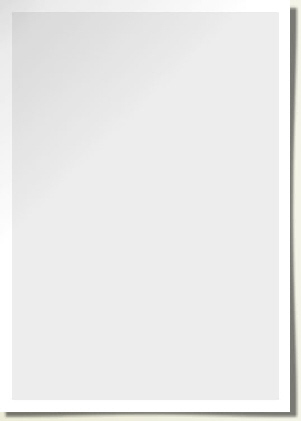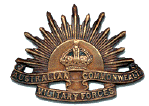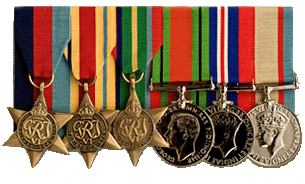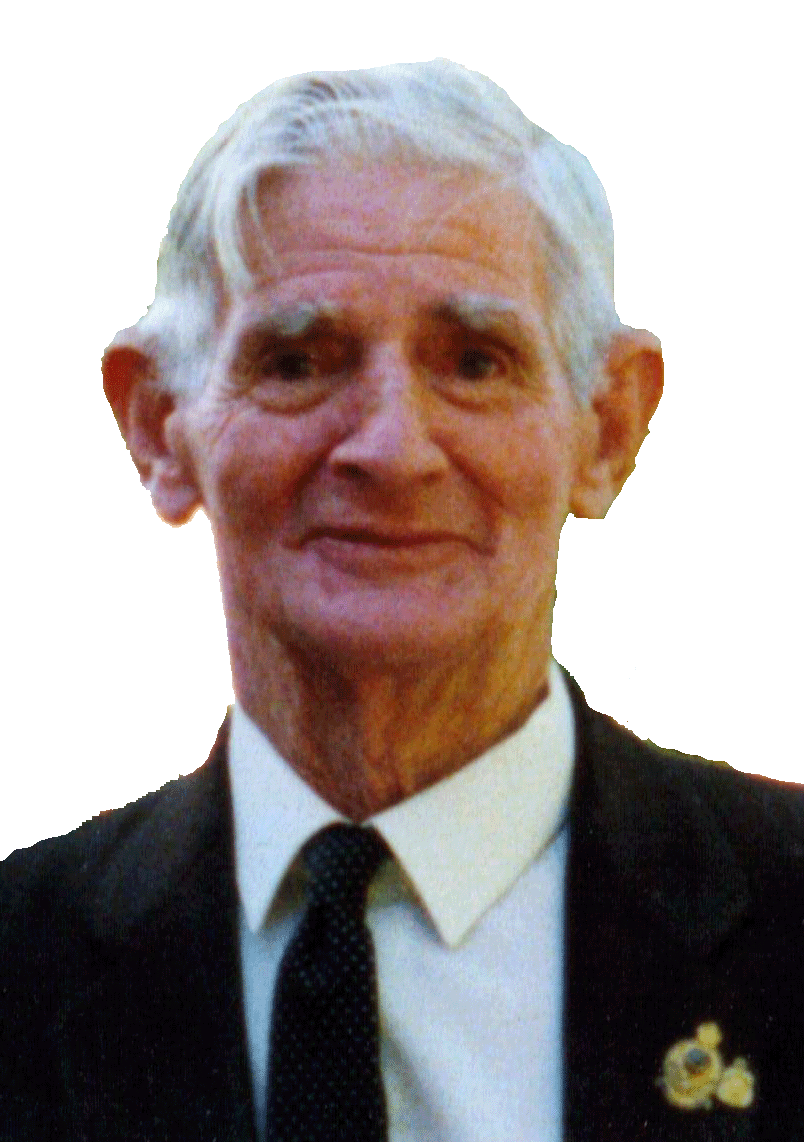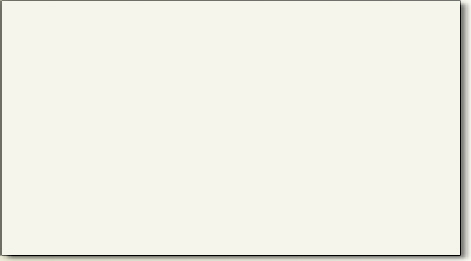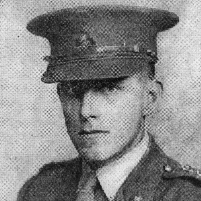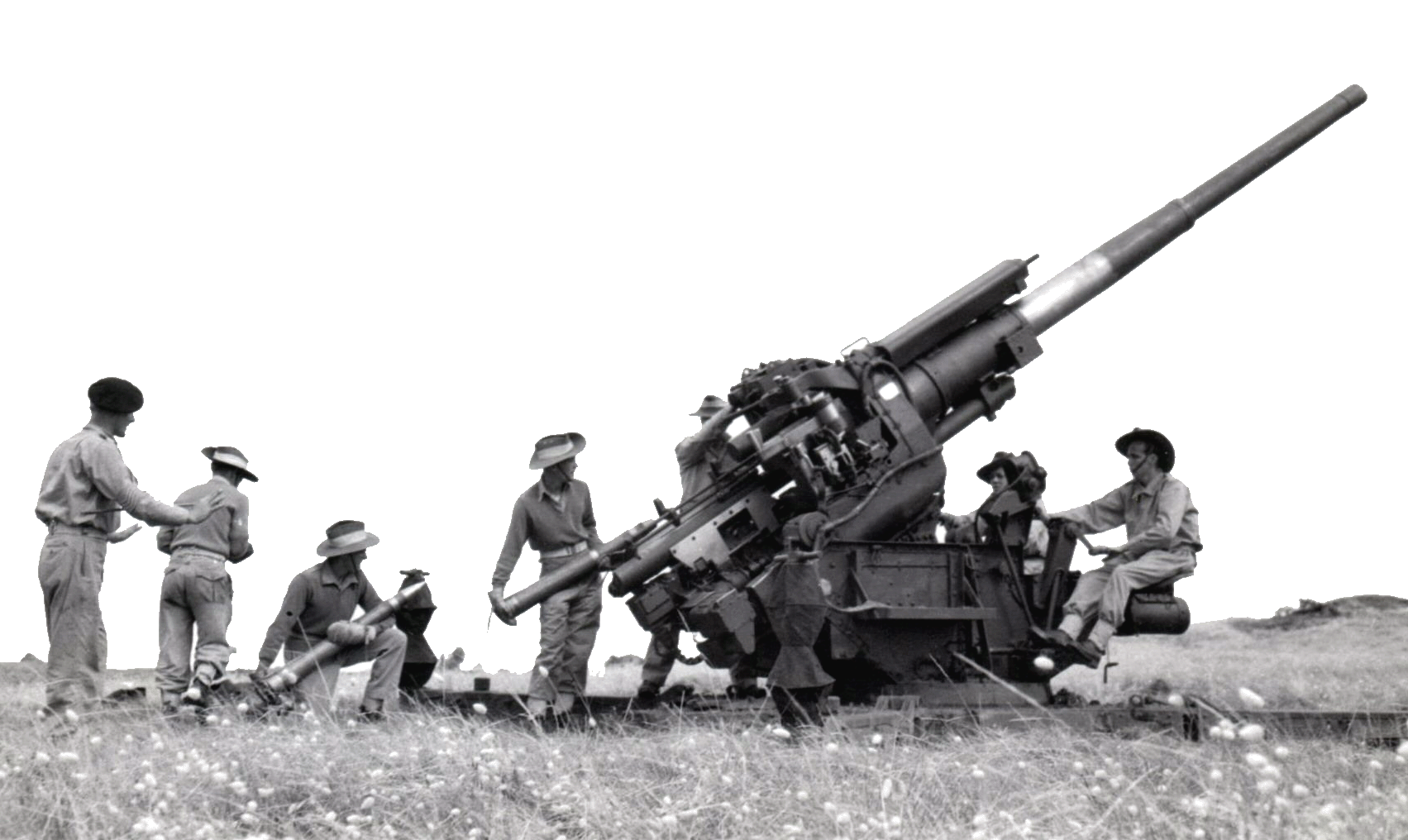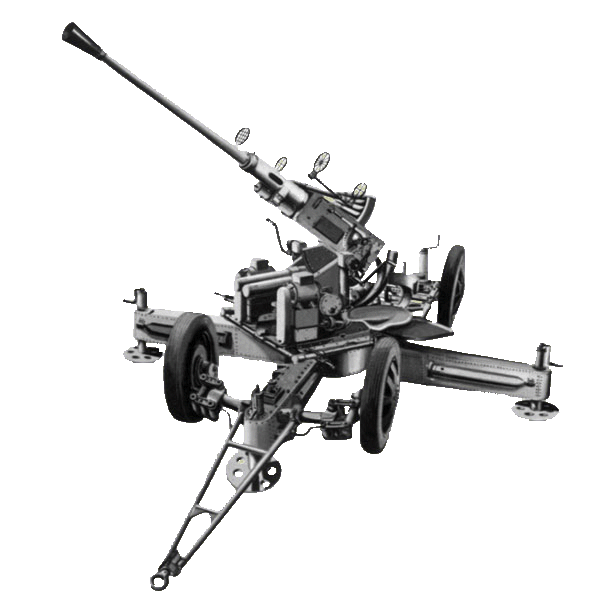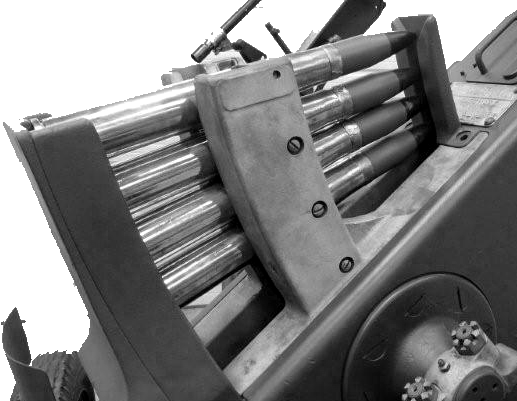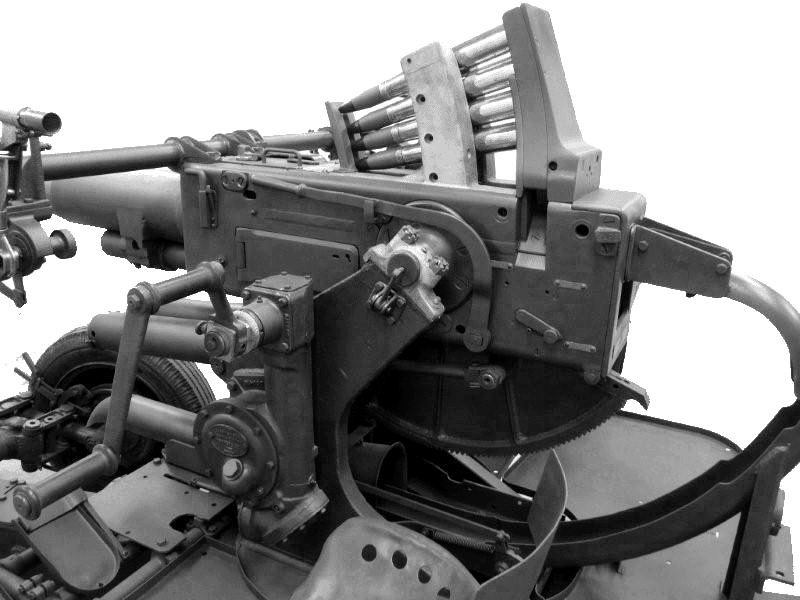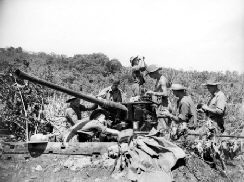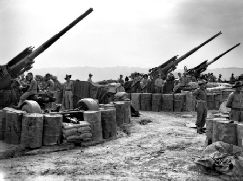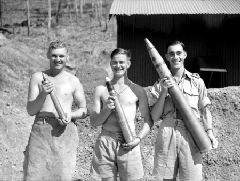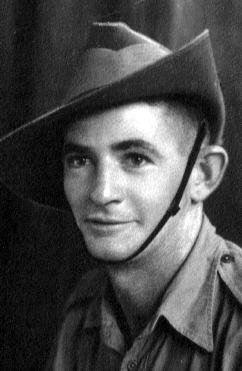Extract from Malcolm's life story: Writen in 1985 at age 75 years.
I was pruning vines for Bob Smith when I decided to join the A.I.F., and went into camp 3 days after my thirtieth birthday – 12/7/40. I trained at the Puckapunyal base near Seymour. It was very cold there, sleeping in tin huts on straw palliasses. I was a truck driver and when we went to the Middle East, I was in corp. troops as a heavy Anti Aircraft Gunner in 2/4th Battery. My army number was VX37192. Bill, Ivan and Alan went into camp at Caulfield then were transferred to Bendigo – after final leave, Ivan and I left for the Middle East on the Moritania, a large passenger steamer converted to a troop ship. It carried 1500 troops. There were four boats in our convoy and we were escorted by the Sydney. Other boats were the Queen Mary, Aquitania and New Amsterdam. The Queen Mary left us later along the way to take troops elsewhere, probable to Singapore. On our journey over, the Sydney spotted a submarine in the Indian Ocean. It left us and we scuttled around in circles. Next morning the Sydney came back and gave the victory sign. They had disposed of the submarine. When we reached Bombay, some of us were transferred to an old boat called the Westernland; it was stinking thing and not very clean. That was the worst part of our journey across the ocean. We had to empty out one of the freezer rooms before arriving in the Middle East. Because some of the meat had gone bad, we were anchored in the Red Sea. There were plenty of sharks milling around the boat; they seemed to follow the boats. When the great legs of beef were heaved overboard, the sharks would take off with them. These long legs of beef seemed more like camel legs to us.
We were getting very browned off by now, and intentionally forgot to lock one of the freezer doors, the contents of which were plenty of beer, canned fruit and other goodies. Somehow a lot went missing that night, and we all had the best feast since we left Australia. Next morning the discovery was made but not a soul knew anything about it. No one admitted responsibility, so we were all fined 20 mills (about 20 cents) each. When we landed at Port Said, we boarded a train, in Louvre trucks and finished up at Cassa, went into a training camp at Julus, where the army took over some citrus groves.The officers told us we could take what citrus we liked to eat. We had a real fill of oranges one night and brought some back to camp. In the morning we found they were full of fruit fly maggots.
One route march we went on, the Officers got lost in the desert – they came to a village where they were paying kids to take us back to camp, but they were too crafty and would sit down and demand more money before moving on further, but we were getting no nearer to camp. The Officers consulted a couple of bushies then and we had to lead them back to camp – all very footsore. From then on we went to Haifa.
The Officers tried to make us shave with salt water while we were there, maybe that started some the skin cancer experienced by a lot of the troops, but I could not come at that, my skin was too tender. My brother Bill arrived in convoy before us. He was in Torbay; we went to Palestine, then on to Syria. I did get to met up with Bill a few times whilst I was there.
While cranking a truck one day, I broke a bone, a small bone, in my wrist. It was never attended to and never did heal. It was very painful handling 3.7 heavy ack ack shells. At Haifa, we were protecting the airspace over oil refineries, we had warned the Jews to board up their windows, knowing that we would soon be attacked by the Germans. They failed to do this and their windows were all blown out by the force during the heavy air raid. We did manage to bring down a few planes and sent a lot of crippled ones limping off. Some of the bombers would explode three times in the air before crashing.
One evening I was on guard duty and I heard a concert going on over the other side of a stone fence. I happened to be there on guard, and asked a chap if the man singing was Ivan Hutchins, he assured me it was. I didn’t think I could mistake his voice, back home Ivan could be heard throughout the Woorinen Settlement, he had a beautiful voice and could imitate some of the worlds most famous tenor’s very well. After the concert I told him that we were camping close by, we certainly had a time of it that night. It is strange how sometimes we are destined to meet, isn’t it. My brother Bill was walking through a battlefield at Tobrook, and they had taken a real battering from the Germans, he happened to see a piece of tin move in a bomb crater – when he pulled it away it was his cousin from Castlemaine; he had been wounded and was hiding there.
During another air raid a land mine was dropped by parachute. We thought it was a dud bomb, and cut the parachute cords off it to get the silk to send home. I still have some of it somewhere as well as some of the silk out of the cords. About four of us ended up sitting on the confounded thing, someone had taken a photo of us and put it in a shop window showing four brave Australians. We were certainly called to order over that little venture – it was no dud.
We did plenty of desert marches with sand flies and some of us contracted sand fly fever. The sand was also full of fleas, they used to get into out blankets, a kind of mohair. We would have to try and belt them out with whatever we could find as they were in thousands. We could see them shining if the blankets were held up to the light.
Three of my brothers – David, Fred and Eric, the latter two being 17 and 18 years of age, enlisted in the A.I.F in July 1941 and were sent as replacements with the 2/21st Battalion. They were stationed in Darwin, but were sent off to the Island of Ambon 500 miles north of Australia. They were sent without any final leave when the Japs came into the war with the attack on Pearl Harbour. I do have a letter Fred wrote to me from Ambon, he said they had no arms or ammunition and that they were doing guard duty with wooden guns. I spoke to my officer about this, he informed me that I could claim them and have them brought to the Middle East, and he would arrange it. Later, he told me all was well and they were waiting on a boat. The island fell before they could be shipped out and they were taken prisoners. My brother Alan who was with the 2/22nd Battalion on the Island of New Britain was reported missing after the Island also fell to the Japanese. We were sent back to Australia, when we got to Java on the Strathaven. We were behind the Strathmore, they had pulled in Java. Sir Edward Dunlop, other doctors and nurses, 22nd Machine Gunners and pioneers were there too. They had to get off to allow civilians to be brought to Australia, so we were told. We were signalled back and did not anchor. We went back to Ceylon, stayed there one night. We had no sooner pulled out of there when the harbour was bombed. An English Officer was aboard and said if you want to make a bet as to where we are going, put your money on Australia. He was so right. We arrived in Perth where we were granted leave, we then went onto Adelaide. We had dinner in the cricket oval there and then boarded trams for McGill where we were billeted.
My mate and I chose to stay with an Italian family, the Beltramis, no one else wanted to go there because we had been fighting the Italians in the Middle East, but they were wonderful people. We used to take their children for walks. One little one in the pram, we entered in a baby competition for the Red Cross, she came second but of course we all reckoned she should have won, as she was such a lovely baby. Mr Beltrami worked at Seppelts Winery, so we had plenty of drink, but only at meal time in true Italian tradition.
We left Adelaide and came across country to Melbourne towing our Ack Ack guns with us, also radar equipment and a convoy of trucks. We had a seven day leave pass before going to Laverton air base. Hughie Nesbit and I went to the Salvation Army for a bed. The place was so packed out I reckon it vibrated with snoring, so we ended up sleeping on the seats at Spencer Station. They were not padded then either, just wooden seats. I think I had three pounds ten shillings ($7) in my pocket but during the night, someone picked my pockets – I never had a penny. I boarded the bus at Laverton hoping I would not be kicked off when I met Dick Oswin – a friend from my home settlement. He kindly paid for my fare and after the war, I duly repaid him. Of all the people I loaned money to in the army, only one from my home town never repaid me.
We trained a Point Cook for a while before going to New Guinea. I witnessed the fight at the Young & Jacksons Hotel between the Americans and A.I.F. men. It all started because the Yanks told the Aussies to throw away their guns and uniforms, “the Yanks are here to protect you now”. The fight went on for hours.
At Point Cook we were training for jungle warfare, a totally different ball game from what we had been used to in the Desert. The army tried to introduce us to using Boys anti tank Rifle. You had to lie on the ground to sight them, but the recoil was so severe they would set you back along the ground and after they have been used a while, they lead up and that made them worse. One day while training I had my jaw shattered from the recoil. I was to suffer much pain with that after going to New Guinea.
When we left Point Cook, we loaded our guns and army trucks on to railway trucks by driving on to one rail track, then driving along the train until we were loaded. We took the back track to Sydney through Shepparton, Numurkah to Tocumwal just over the Murray River in NSW. We had to transfer all the gear onto the narrow gauge train at Tocumwal. We arrived there at 2am in pouring rain and freezing cold. The ropes had shrunk and we had difficulty untying them to transfer the vehicles. Each driver had to sit in the cabin of his truck from Melbourne to Sydney, and we almost froze. We had a meal at Seymour, a cup of tea at Shepparton, tea and breakfast all in one at Tocumwal. We could not even run the truck engines to keep ourselves warm as there was only enough petrol in them to load and unload them. They were open trucks with only canvas side blinds to keep out the rain and wind. We finally reached our destination only to find there was a wharf strike on and we could not unload any of the equipment onto the boats. The strike went on for a few days and we had an unofficial leave during that time. We went on to the harbour bridge and a couple of Americans were there too, my mate commented that the bridge was not a bad piece of construction. The Yanks said ‘Yes I would sure like to have it home in the backyard for the kids to play on’. My mate’s reply was ‘When you get home, if you can suck as hard as you can blow mate, you will probably get it’.
We were sent to the Liverpool camp and when we finally boarded the boat to leave I became ill with the mumps. I was taken away to hospital with two or three other chaps. After being discharged from hospital, we went to St George’s Heights Army base.
My own unit had gone on to New Guinea. I tried all sorts of ways to catch them up, but to no avail. George’s Heights was a Militia base and didn’t seem to want anything to do with returned men. Some of the 4th, 5th and 6th Batteries were also there. During this time, three Jap subs were destroyed in the harbour. I was transferred to 156 Light Ack Ack battery, a Militia Unit and was made a Bombardier. At Canterbury, we were made airborne troops, but went to Port Moresby (New Guinea) by boat. We put in months there protecting the wharf and aerodromes.
We were transferred to the Wau Aerodrome across the Owen Stanley Ranges and the only way to get there was through a narrow pass, leaving very little room to spare with the wings on each side of the aircraft. We put in weeks mantling and dismantling guns and loading them on to an old biscuit bomber on the drome before we left there. We made several attempts to fly through the pass but turned back because of fog. The American Pilots abandoned the idea and eventually the Australian pilots took us through. We landed with a skeleton crew and very few provisions, just whatever equipment could be brought in with a few planes that managed to get through. Sometimes it could be weeks before the planes could negotiate the pass again. Of course other places were affected in the same way – Bololo, Poppendata, Finchaven and others.
We assembled out guns near the Wau aerodrome and only had a limited supply of ammunition, which we were only supposed to use on aircraft in an emergency until more arrived. However, we met up with the remnants of the 17th brigade (infantry). Captain Sherlock was in charge at the time, the brigade had really taken a battering. He gave orders to us to train our guns on the jungle across the aerodrome. Our Officers had not arrived, and we hesitated to do this being an Anti Aircraft Crew, with no back up of supply ammo. He informed us that he would take full responsibility for action and if we run out of shells we were to take to the bush, there was only one way to go to try and escape. There were head-hunters in one direction, the Japs in another, and the Owen Stanley Ranges another way – almost impossible to get through.
We obeyed his orders and the next morning at first light we caught the Japs having breakfast and at least a thousand Japs were killed there, they had been readying themselves to knock out our guns and skeleton crew. That incident was the start of the battle for Wau. The 17th Brigade had suffered heavy losses and eventually the Brigade was almost wiped out. I was beginning to have trouble from the fractured bones in my face, it was very swollen and painful and there was no doctor to attend to it, then a flying dentist came into Bololo. I managed to see him there and he was horrified at the state of it, and removed a piece of jaw bone that had worked down to the roof of my mouth. I had also been suffering nose bleeding for days with it.
My original unit copped a thrashing when they went in at Finchaven, and lost a few men – perhaps luck was on my side. A convoy of Japanese troops was coming through the Straights of Macassa, a very large convoy and the Australian pilots there went out to intercept in the flying fortresses and Liberator heavy bombers. There were so many of the enemy, the pilots decided the only way to stop them was to use the heavy bombers as dive bombers – almost a mission impossible. However, not one boat got through, they sank the lot, but for their efforts they were grounded for misusing the planes. They had American co-pilots who did not like the methods, then word came through that another convoy was on its way, so the Australians were given back their wings and allowed to do the same again. If these convoys had been successful in getting through, it would have been good night Australia, even with American assistance.
When things were quiet in New Guinea, we used to make trinkets and sell them or keep them for souvenirs. I used to get aluminium from the Jap planes shot down in the jungle, and make photo frames in the form of the map of Australia. I have even found a lot of gold. I made my Lieutenant’s bride’s wedding ring and they were married in New Guinea. When rations were short, which was pretty often, we used to shoot a wild pig and when we made a kill, we would fire so many shots to signal the camp to have the waters hot to dress it. By this time, the Japs were not around us – it was mainly air fighting. Wild pumpkins would trail up the trees in the jungle and we would shoot them down for vegetables. We had bunches of bananas and wild tomatoes, sweet potatoes, but would have to go bush to get them. The little black boys would skim up the coconut trees to get coconuts for us. We owe a lot to the Fuzzy Wuzzy angels who used to act as stretcher bearers for our wounded men. White man could never have done what they did. In New Guinea, one could hear the mosquitoes coming for miles at about 4pm. They were worse that the Egyptian sand flies; impossible to sleep without a mozzie net. Some men would nearly go crazy with the noise of those insects.
Somehow they used to creep under the nets, the men would roll out of bed and sometimes have to be taken to hospital – I was in hospital with dengue fever or malaria. Attabrin tablets were the treatment. I also had dysentery and at that time, our hospital was bombed and the baker and several others were killed. I had a few bouts of malaria after returning home and still had to take Attabrin for recurring attacks.
The only amusement in New Guinea was an occasional picture show when things were quiet and a game of two up. We had plenty of earth tremors and the humidity was oppressive and the rain came down in sheets. I remember we dug slip trenches to take cover at Port Moresby when we were not allowed to intercept the enemy because our planes were having a dog fight up top with the Zero’s, that often happened too. One American black man used to take refuge in our trench rather than dig his own, so we put a harmless green snake in the trench to try and cure his habit, the next raid he still jumped in and said ‘move over there reptile, there has to be room in here for me too’.
I won quite a lot of money at two up but our boat was delayed when we were to come home on leave after two years, and I ended up playing until I lost the lot before we sailed, but that was part of life over there.
There was an old buggy at the camp and the Americans thought it bomb proof, and used to shelter in it, but one night they didn’t use it and the Japs riddled it with bullets in an air raid, seems it is all a part of destiny – a game of luck whether you live or die. I had some close calls during my war years and I thing myself lucky although I have suffered the results of war ever since, like many other soldiers.
I met my friend Fred Koch in Canterbury NSW before I went to New Guinea and we remained close friends throughout the ordeal, and have been ever since. Fred was my banker and used to lay my bets at two up for me, and if I was having a losing night, he was as hard to extract money out of as a bank manager during the depression. The troops had already given me the nick name of Spinner Hutchins. I even gave my Lieutenant 500 pounds ($1000) to hold for me and told him not to give it back until we sailed for home. When I was losing I pestered him until he gave it back and of course, I lost that too.
I made some trinkets from the gold I had collected over there for myself and my wife. We were not supposed to bring gold out of New Guinea, so we would try to hide it in various places before inspection. I was unfortunate enough to lose those of mine, but managed to get home with my wife’s. I had made a very large gold ring for Fred and he got home with that.
The Australian engineers made a road through from Torapo to Wau. The Bulldog Trail through the Owen Stanley’s, in places it was 7000 feet above sea level. To get it finished quickly they floated bridges on oil drums. Many tractors were lost over the sides of mountains. Bull dozers too went over and many men were killed. Down the slopes the tracks were corduroyed, the tropical rain would cause land slides and tons of mud would have to be pushed off the track quite frequently. When we left Wau, we came over the Bulldog Trail.
We marched part of the way over, a lot of material and big guns had to be left behind, then we picked up trucks down at a village for the rest of the journey. Only the Australian engineers would tackle cutting that trail through and what an achievement it was too.
We found jungle warfare far worse than open war in the Middle East. We had two years service in the tropics before getting leave. When I arrived back in Australia, I met up with my brother Bill again at an army camp out of Brisbane. We were camped at Strathpine. My belongings had been in storage from when I went to New Guinea, I went to pick them and found that they were destroyed in a fire while I was away.
We came back to Melbourne by train from there, then went on leave and I was married on 19/2/44, before returning to Brisbane to rejoin my unit. I had to report to a specialist in regards to my facial and nose problems (which I have already explained about). I was feeling pretty miserable at the time, knowing my four brothers were still in the hands of the Japanese, not knowing what had happened to them. After all, I was the eldest of the seven of us in the Army. I had helped to take care of the younger ones from when they were babies, when the doctor at Toowoomba told me he was making me Class and sending me home for a discharge, I was outraged and told him I wanted to fight on, on account of my brothers. He said ‘You have had enough’ its time to go home. I was sent back to Melbourne where I was discharged in July 1944, at Royal Park base. When I returned home I went to work for Mr Cocroft at Woorinen again. I used to ride a push bike out from Swam Hill every day but I had not recovered enough to face the headwinds, so I went to work at Leo Cohn’s Cordial Factory in Swam Hill.
My wife was a divorcee with a loveable little daughter whom I adopted in later years. She learned piano, elocution and did very well in competitions. Ray, my son, was born in 1945. He had a few problems early suffering from encephalitis during the Murray River outbreak that killed and affected many people in Swan Hill. Fortunately Ray recovered after causing the doctor and ourselves many anxious moments.
The war was over -It had been 4 years without any news of my brothers David, Alan, Eric and Fred. In February 1946 news came when four telegrams arrived – all four of my brothers paid the supreme sacrifice for their country at the hands of the Japanese. As I have mentioned before, their deaths affected my parents terribly. My brother Ivan selected a soldier settlement vineyard at Robinvale, but after some years, he passed away prematurely too (after much suffering). Bill and I are the only ones left and are the eldest of those who went overseas, we are both in poor health, but we manage. It is 50 years since the war ended but there is not a day that goes by that I do not think of the war and the sacrifice my brothers paid.


